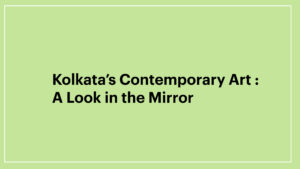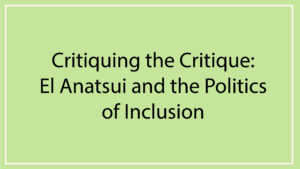Sunanda K Sanyal
(Published: Art News & Views, 3(4), December, 2010: 29-31)
To put it rather bluntly, it is impossible to write an exclusive history of modern sculpture. Though one could make the same argument about modern painting, it certainly is more relevant to sculpture; for unlike painting’s occasional insistence on purity and self-critique (as with Abstract Expressionism), sculpture of the last century has been more consistently engaged in self-deconstruction, opening itself to complex dialogs with almost every other medium and mode of expression: painting, photography, architecture, landscape, video, light, sound, motion, language, not to mention the human body. Sculptural practice today is thus infinitely more hybridized than the enterprise of painting. Instead of attempting a survey of such a complex history, this brief essay touches on some of the key attributes of American sculpture of the 1960s.
Civilian life in the United States was unscathed by World War II. So while much of postwar European art bore dark memories of trauma and destruction, American art from the same period was largely indifferent to the social and political changes at home and abroad. Instead, it was deeply involved in its own discourse. The differences among them notwithstanding, all the post-war American trends —Abstract Expressionism, Pop, Happenings, Minimalism— were essentially hermetic in character, underscoring self-referentiality as art’s primary goal. But whereas Abstract Expressionism’s high-winded, anxiety-ridden, author-centered rhetoric of self-referentiality was all about the processes and materials of art-making, Pop art in the ‘60s insisted on the self-referentiality of signs by collapsing the barrier between “high” and “low” cultures. Tawdry images of soup cans, coke bottles, Mickey Mouse and living as well as dead celebrities emerged as unstable, thoroughly mediated signs in a media-driven consumer culture, with no hierarchy of values. Pop owed much to the Dada strategies of Marcel Duchamp, yet it bypassed Duchamp’s biting social critique to eagerly embrace capitalist materialism with a non-committal gesture, articulated through wit and irony— an attitude often summarized in the expression “deadpan cool”. Thus repudiating the conventional supremacy of the artist-author, Pop’s self-referential images signaled the end of a discourse of art that had reigned since Manet and Courbet. Minimalism emerged in the late ‘60s with curious ties to Pop.
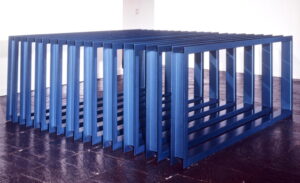 Donald Judd, Untitled, 1966.
Donald Judd, Untitled, 1966.
Minimalism’s rigorously reductionist simplicity seems to recall the geometric abstractions of prewar Europe: Mondrian, Malevich, Gabo, the Constructivists, and the Bauhaus. But what legitimates it as a movement is its specific context; and in that regard it is quintessentially American. Sculptors like Carl Andre, Donald Judd, Robert Morris, Tony Smith and a few others exhibited simple, abstract shapes that are no less recognizable as objects. A cage-like metal structure by Judd, painted with industrial color; or a stack of bricks on the gallery floor by Andre, with its original texture, are thoroughly literal, impersonal constructs: what you see is what you see.

Carl Andre, Equivalent VIII, 1966.
Among other things, Minimalism was a response to the emotional vibrancy of Abstract Expressionism. “Sculpture”, the veteran Abstract Expressionist painter Barnett Newman supposedly remarked in the ‘50s, “is what you bump into when you back up to see a painting.” Whether factual or not, the comment offers a glimpse of sculpture’s marginal status in a movement that adamantly privileged painting as the ideal medium of self-expression. And it is this Modernist attitude that Minimalism snubbed. Rejecting the pedestal —the conventional marker of the boundaries of sculpture— and denying any underlying notion of utopia, transcendence, or, in Rosalind Krauss’s terms, “internally dictated outer limits”,[1] Minimalist sculpture unequivocally stands apart from all other legacies of abstraction. The strictly serial, repetitive order uses the grid as its structural unit, echoing the monotony of industrial mass production as much in material as in appearance. Even while appreciating its abstract shape, one is likely to be puzzled by the realism of its object identity —a box, a metal cage, a stack of bricks— in a gallery setting, which would then beg the question: is it art? Minimalism thus draws on the Duchampian Readymades via Pop. Warhol’s Brillo Boxes are cardboard replicas made in the same scale as actual brillo boxes, with the brand meticulously painted on all sides. Thomas McEvilley identifies this sort of work as “anti-sculpture”.[2] Stacked up on the gallery floor like a supermarket display, it denies any depth or narrative. It is what it is. Take away the brand and the colors, and it becomes a Minimalist piece. The Pop “cool” turns into cold fact.
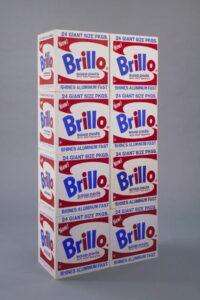
Andy Warhol, Brillo Boxes, 1964.
This matter-of-factness of Minimalism is precisely what enraged Modernist critics like Clement Greenberg and his disciple Michael Fried. Fried argued in an influential essay that in order to become a sculpture, an object must be aesthetically transformed by shedding its objecthood. Minimalism, he contended, depended too much on what he called theatricality —its incongruous relation with the gallery space and viewer participation— to be considered serious art. [3] It soon became clear that language was crucial to the shaping of the discourse of such a reductionist art, and this motivated the Minimalists to take up the pen to combat Fried’s rhetoric. In numerous essays and reviews, almost all of them defended their individual positions, if not a seamlessly collective one. Intense word games became integral to American art discourse in the late ‘60s.
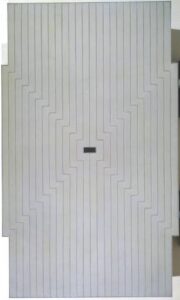
Frank Stella, Six Mile Bottom, 1960.
Frank Stella, however, occupies a particularly intriguing position in the same milieu. In his Six Mile Bottom (which predates most Minimalist work), not only do the pin stripes on a ground of shiny aluminum paint cover the canvas edge to edge (even around the edges of the thick stretcher bar), but the shape of the canvas and the design on it faithfully echo each other. It was Stella who actually popularized the remark “what you see is what you see” about his own work; yet what exactly does one see here? Casting real shadows on the wall, the thickness of the stretcher bar accentuates the objecthood of the image, like a relief work on the wall; but then again, the imprecise pin stripes of varying thicknesses occasionally bleeding into the ground of the canvas also betray the painted character of the surface. Thus, the tension between its identities as a shape and an object becomes more intense than with any Minimalist sculpture: it also becomes a fundamental tension between sculpture and painting. Precisely because of this, Stella was denied serious attention by Greenberg, whereas Michael Fried argued in his favor. According to Fried, the shimmering surface of the canvas covered with aluminum paint generates an optical effect, which, despite Stella’s manipulation of the conventional pictorial format, sustains the integrity of the image as a painting.[4] For Fried, therefore, it is an objectlike shape, rather than a shaped object. Carl Andre, on the other hand, saw it precisely from the other end, so that Stella could be identified as a Minimalist painter.

Dan Flavin, “Monument” for V. Tatlin I, late 1960s.
If Stella, then, straddles the line between Modernism and Minimalism, Dan Flavin provokes the debate over objecthood and opticality in quite a different way. His fluorescent rods function on two levels. The lights turned off, the wall-mounted simple compositions are no less Minimalist objects than those by Andre or Judd. And once lit, they become a tongue-in-cheek response to Modernism’s insistence on opticality. After all, what could be more optical than light? Needless to say, Greenberg and Fried considered this an outright travesty, since opticality to both of them was an effect exclusive to painting, caused by the interaction of paint pigments and the picture surface. Nonetheless, such a stretch of the Modernist logic of optical effect was effective in moving sculpture toward what Rosalind Krauss identifies as sculpture’s “expanded field”, where sculpture is characterized by absence rather than presence— by what it is not rather than what it is.[5] Unlike Flavin, the Los Angeles-based artist James Turrell drives a wedge between three-dimensionality and tangibility by concealing the source of his light. His Afrum-Proto is a bright halogen projection on the gallery wall, a luminous presence that produces an illusion of a solid cube suspended in mid-air. If a sculpture is a body projected into the void, then Afrum-Proto is a projected body indeed (quite literally so), albeit not a tangible one. Rather, it sacrifices its objecthood to become an experience of light in space. Drawing on Minimalism’s reductionist strategy, Turrell transgresses the Minimalist mandate to produce a paradox of presence and absence: what you see is what you see (light), yet you also see what isn’t there (solid cube).
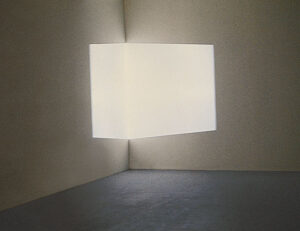
James Turrell, Afrum-Proto, 1966.
Turrell would later produce deeply enigmatic, giant installations in outdoor settings by manipulating natural light. In such endeavors, he would be one of a group of artists —Robert Smithson, Michael Heizer, Christo & Jeanne-Claude and others— who moved beyond the gallery walls to make either permanent or temporary marks on sites of architecture and landscape. Loosely labeled Earth Art or Land Art, theirs were immense undertakings that were meant, among other things, to defy commoditization of art and farther expand the field of sculptural practice.
Notes:
[1] See Krauss, Rosalind, Passages in Modern Sculpture. Cambridge, Mass.: MIT Press, 1990: 250.
[2] McEvilley, Thomas. Sculpture in the Age of Doubt. New York: Allworth Pres, 1999: 44.
[3] See Fried, Michael, “Art and Objecthood”. In Michael Fried, Art and Objecthood: Reviews and Essays. University of Chicago Press, 1998.
[4] Fried, Michael, “Three American Painters”. In Michael Fried, Art and Objecthood: 256.
[1] See Krauss, Rosalind, “Sculpture in the Expanded Field”. In Rosalind Krauss, Originality of the Avant-Garde and Other Modernist Myths. Cambridge, Mass.: MIT Press, 1985.

